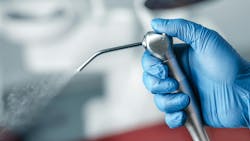What’s in your dental unit waterline? DUWL safety recommendations
If you were the first patient of the day in your chair, would you feel safe having the water in your mouth? When is the last time you flushed your lines before or between patients? Is the water in your dental unit waterline safe to drink? These are questions dental hygienists should be asking ourselves. Ultimately, our patients’ health and safety is our concern and waterlines are a critical part of our responsibility.
In October 2022, the CDC issued a health advisory regarding waterlines after nontuberculous outbreaks of Mycobacteria infections in pediatric dentistry in 2015 and 2016.1 Dental waterlines contain multiplying microorganisms that create biofilm. (Yes, biofilm!) What better place for biofilm to develop than the dark, moist, small tubing of stagnant water in our offices?
Waterline treatment and maintenance will make water safe to consume by bringing it to recommended standards. According to the Environmental Protection Agency (EPA), regulatory standards for drinking water is ≤500 colony forming units [CFU]/mL of heterotrophic water bacteria, which is acceptable for nonsurgical procedures.2 How do we attain that safe level? Let’s dive into the recommendations.
Recommendations for dental unit waterline safety
Waterlines need to be tested and maintained regardless of whether your office uses a closed bottled water system or municipal water. Unfortunately, the CDC recommendations are somewhat vague. They recommend that waterlines be treated “regularly” and monitored “routinely.”2 Because of these generalized statements, we must establish our own written policies and procedures to achieve the EPA standard. These policies and procedures should derive from the equipment manufacturer’s instructions for infection control procedures for monitoring and maintaining water quality; the CDC, state, and local guidelines; as well a dental waterline products.
Policies should include protocols for testing frequency, steps in the event of a boil water advisory, failed test (>500[CFU]/ML), and extended office closure recommendations. When testing waterlines, all lines in each operatory should be tested. This includes all air/water syringes, unused waterlines, ultrasonic scaler, and high-speed handpiece lines.3
To remove or inactivate biofilm from waterlines, a chemical germicide must be used. This is known as shocking the waterlines and must be done according to manufacturer instructions. The most common shocking chemical is diluted bleach (1:9 bleach to water ratio), which is safe according to most dental unit manufacturers.4 Additionally, it’s recommended to flush waterlines every morning for two minutes and for 20–30 seconds between patients to eliminate contaminants that may have gotten into the lines during treatment.5
A boil water advisory issued by a public health department means the water is unsafe to drink and should not be delivered to the public through dental units. Bottled water should be used until the advisory is cancelled, unless the office water is isolated from the municipal water system. Once the advisory is cancelled, the health department will give guidance, but flushing all incoming waterlines is suggested.6
Monitoring waterlines can be done in the office with self-testing kits. Most manufacturers recommend quarterly or monthly testing.7 If waterlines fail the test (>500[CFU]/ML), they should be shocked and retested. Documentation of waterline testing is essential and must include the test date, location (operatory), water source (i.e., air/water syringe, ultrasonic), test results, and the team member performing the test.
While waterline maintenance and monitoring can feel frustrating and tedious, it’s non-negotiable. This is an ethical responsibility and a concerning issue that requires our commitment. Not all offices have protocols in place yet, so it’s time we all get on board. Each office is encouraged to have an infection control coordinator who is responsible for waterline compliance. Dental hygienists understand why this matters, and we have the knowledge and background to lead this task. Step up and volunteer to keep our patients safe!
Do you know what’s in your waterlines?
References
1. Outbreaks of nontuberculous Mycobacteria infections highlight importance of maintaining and monitoring dental waterlines. Centers for Disease Control and Prevention. 2022. Accessed April 10, 2025. https://archive.cdc.gov/#/details?url=https://www.cdc.gov/han/2022/han00478.html
2. Best practices for dental unit water quality. Centers for Disease Control and Prevention. 2024. Accessed April 11, 2025. https://www.cdc.gov/dental-infection-control/hcp/dental-ipc-faqs/best-practices-dental-unit-water-quality.html
3. Dental unit waterlines. American Dental Association. 2024. Accessed April 11, 2025. https://www.ada.org/resources/ada-library/oral-health-topics/dental-unit-waterlines
4. How to shock dental waterlines. ProEdge Dental Water Labs. 2022. Accessed April 11, 2025. https://proedgedental.com/toolkits/how-to-shock/
5. Dental unit waterlines. US Food and Drug Administration. 2018. Accessed April 11, 2025. https://www.fda.gov/medical-devices/dental-devices/dental-unit-waterlines
6. Guidelines for infection control in dental health-care settings–2003. MMWR. December 19, 2003. Accessed April 10, 2025. https://www.cdc.gov/mmwr/PDF/rr/rr5217.pdf
7. Dental waterlines: CDC compliance and protecting your practice. Henry Schein Dental. 2022. Accessed April 11, 2025. https://www.henryschein.com/us-en/dental/events-education/article-safe-waterlines.aspx
About the Author

Rochelle S. Thompson, BSDH, RDH
Rochelle S. Thompson, BSDH, RDH, has more than 28 years of clinical experience. She has served as the continuing education chair for the Richmond component of VDHA and as a clinical dental hygiene instructor. She is currently the OSHA compliance officer in the dental office where she practices, and a freelance writer. For more information, email her at [email protected].
